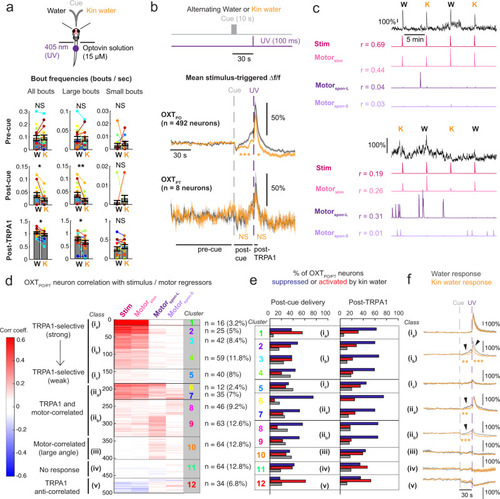|
Manipulation of OXT signaling affects appetite in a social-context- dependent manner.a Schematic depiction of social feeding behavior experiments. Example images are shown (inset shows higher (100x) magnification). b Left: Gut fluorescence in a single experiment demonstrates that isolated fish, on average, ingest less paramecia than fish maintained in a group of 3 conspecifics. All gut fluorescence measurements are normalized to the group mean (**p = 0.0058, n = 21/17 fish, two-sided Wilcoxon rank-sum test). Right: Normalized food intake (gut fluorescence normalized to the average for groups of 3 fish) scales with group size (1 fish, n = 36; 2 fish, n = 7; 3 fish, n = 52; 5 fish, n = 29 over 4 experiments). **p = 0.0065 (1 fish vs 3 fish)/**p = 0.0035 (1 fish vs 5 fish), two-sided Kruskal–Wallis test with correction for multiple comparisons. Data are presented as mean values ±SEM. c Water-borne but not visual cues rescue reduced feeding of isolated fish. Left: Results within a single experiment. *p = 0.03 (isolated vs group), *p = 0.04 (isolated vs kin water), p = 0.17 (isolated vs visual), n = 24/24/22/23 fish, two-sided Wilcoxon rank-sum test. Right: Average of 6 experiments, p = ***2.8283 × 10−4 (single vs group), *p = 0.02 (single vs kin water), p = 0.35 (single vs visual), n = 86/86/55/87 fish, two-sided Wilcoxon rank-sum test. Data are presented as mean values ±SEM. d Cell-specific chemogenetic ablation of OXT neurons specifically rescues the effect of social isolation on appetite. OXT neurons were ablated via OXT neuron-specific expression of bacterial nitroreductase using Tg(oxt:Gal4;UAS:nfsb-mCherry) fish6, 44. Animals were incubated with a group of conspecifics and the prodrug metronidazole (MTZ) during the period from 5 to 7 dpf. This treatment resulted in loss of ~80% of nitroreductase-labeled preoptic OXT cells (unablated = 20.3 ± 1.1 neurons, ablated = 4.5 ± 0.5 neurons; n = 20 control fish, 29 fish with ablation). *p = 0.015 (isolated control vs group control), **p = 0.0017 (isolated control vs single ablated), p = 0.76 (isolated ablated vs group ablated), n = 65/59/57/56 fish over 5 experiments, two-sided Wilcoxon rank-sum test. Controls are metronidazole (MTZ)-treated, non-transgene-expressing siblings. Data are presented as mean values ±SEM. e The oxytocin receptor antagonist (L-368,899) restores social feeding levels to isolated animals. Antagonist (5uM) was added to the incubation water at the start of the 2-hr isolation period (see (a)). Data are presented as mean values ±SEM. **p = 0.0022 (single vs group), **p = 0.0091 (single control vs single antagonist), p = 0.09 (single antagonist vs group antagonist), n = 40/50/29/34 fish over 3 experiments, two-sided Wilcoxon rank-sum test. Data are presented as mean values ±SEM. f An oxytocin receptor agonist (WAY 267,484) (5 µM) reduces group food ingestion to the level of isolated animals. Agonist was added to the incubation water at the start of the 2-hr isolation period (see (a)). **p = 0.0022 (single vs group), p = 1 (single control vs single agonist), **p = 0.0069 (group control vs group agonist), n = 40/50/20/21 fish over 3 experiments, two-sided Wilcoxon rank-sum test. Control groups for both (e) and (f) are the same sets of fish, split up for better visualization. Data are presented as mean values ±SEM. g Comparison of food intake of oxt null mutants (oxt−/−) and their heterozygous wild-type siblings (oxt+/−) in isolated and nonisolated contexts Single-group differences in food consumption are abolished—however, food intake was reduced in groups, rather than enhanced in isolated fish. **p = 0.0011 (single vs group), p = 0.65 (single control vs single mutant), **p = 0.0012 (group control vs group mutant), n = 60/59/58/54 fish over 5 experiments, two-sided Wilcoxon rank-sum test. Data are presented as mean values ±SEM. h Model for how oxytocin neurons integrate information on social state to control appetite and nocifensive behaviors. We posit that social chemical cues are olfactory, and that GABAergic neurons in the subpallium transform olfactory bulb activation into inhibitory signals that differentially modulate the OXT population. The OXT circuit modulates nocifensive behavior via brainstem premotor neurons6. The OXT neurons project extensively to other areas of the hypothalamus and the pituitary; these downstream regions may be involved in mediating effects on appetite43. Source data are provided as a Source Data file.
|







